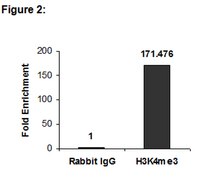05-745R-S Sigma-AldrichAnti-trimethyl-Histone H3 (Lys4) Antibody, clone 15-10C-E4, Trial Size
Use Anti-trimethyl-Histone H3 (Lys4) Antibody, clone 15-10C-E4, Recombinant, Trial Size (rabbit monoclonal antibody) proven in WB, ChIP, ChIP-seq, ELISA, PIA, Mplex, DB to detect trimethyl-Histone H3 (Lys4) also known as H3K4me3.
More>> Use Anti-trimethyl-Histone H3 (Lys4) Antibody, clone 15-10C-E4, Recombinant, Trial Size (rabbit monoclonal antibody) proven in WB, ChIP, ChIP-seq, ELISA, PIA, Mplex, DB to detect trimethyl-Histone H3 (Lys4) also known as H3K4me3. Less<<Recommended Products
Overview
| Replacement Information |
|---|
Key Spec Table
| Species Reactivity | Key Applications | Host | Format | Antibody Type |
|---|---|---|---|---|
| H | WB, ChIP, ChIP-seq, DB, ELISA, PIA, Mplex | Rb | Purified | Monoclonal Antibody |
| References |
|---|
| Product Information | |
|---|---|
| Format | Purified |
| Presentation | Protein A purified, recombinant antibody in 60 mM Tris, 90 mM NaCl, 0.03% NaN3, 60 mM Glycine, pH 7.5, 40% Glycerol. |
| Quality Level | MQ100 |
| Physicochemical Information |
|---|
| Dimensions |
|---|
| Materials Information |
|---|
| Toxicological Information |
|---|
| Safety Information according to GHS |
|---|
| Safety Information |
|---|
| Packaging Information | |
|---|---|
| Material Size | 10 µL |
| Transport Information |
|---|
| Supplemental Information |
|---|
| Specifications |
|---|
| Global Trade Item Number | |
|---|---|
| Catalogue Number | GTIN |
| 05-745R-S | 04053252946844 |
Documentation
Anti-trimethyl-Histone H3 (Lys4) Antibody, clone 15-10C-E4, Trial Size SDS
| Title |
|---|












